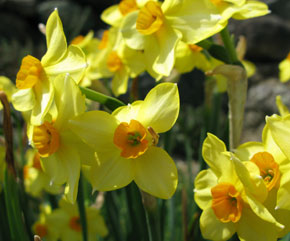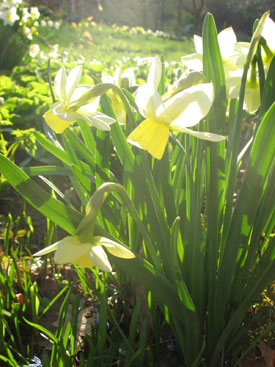





As a founding employee of Gardener's Supply, I wore many different hats over the years. Currently, I have my own company called Johnnie Brook Creative. The gardens around my home in Richmond, VT, include a large vegetable garden, seasonal greenhouse, cutting garden, perennial gardens, rock garden, shade garden, berry plantings, lots of container plants and a meadow garden. There's no place I'd rather be than in the garden.

Over the years, a small clump of daffodils will become a substantial drift.
Like many gardeners, I'm feeling a pinch in my pocketbook, and it has me thinking twice about how much I spend on my garden.
As summer draws to a close, it's tulips, hyacinths, alliums, lilies and other fall-planted bulbs that tempt me.
If you find yourself feeling the need to justify this year’s investment in bulbs, I have a suggestion: daffodils.
Daffodils deliver—by far—more flowers for a longer time with less care than any other bulbs you can plant. They’ll thrive just about anywhere, and they come back year after year in ever greater numbers. Over time, even a small planting of 20 bulbs will gradually become a swath of color with a hundred or more blooms.
The world’s flower breeders spend their lives developing new ways to tempt gardeners like us with ever more beautiful blooms. Daffodils breeders have been particularly successful in introducing new varieties in a range of heights, colors, flower forms and bloom times. No matter how many daffodils you already have (and I have a few!) there’s always a new variety to add to your collection.

Daffodils are well-suited to a technique called "naturalizing," which means planting bulbs in natural-looking drifts.
Another great thing about daffodils is that you don’t need to squeeze them into your flower beds. In fact, daffodils are best planted just about anywhere other than in a flower bed. Many years ago, I put some daffodil bulbs into my perennial borders and I’ve been digging them out ever since. They do provide a great hit of color in early spring, but the ever-multiplying bulbs and their messy spent foliage steal space from other perennials in the garden.
If you’re not going to plant daffodils in your flower beds, where should you plant them? In my opinion, daffodils are at their best when they’re “naturalized” in the landscape. This means planting the bulbs in clumps or drifts that appear to be somewhat randomly placed—as if nature did the planting. To capture this natural look, it’s essential to plant the bulbs in groups of five or more. Scatter the plantings around so they look like they’re popping up beneath shade trees, in shrub borders, along a fence, in a woodland, near a pond or stream, in a meadow, next to the mailbox, or even right in the lawn.
Plant your daffodils bulbs in October or November, at least 6″ deep—8″ is better. Cluster small groups of bulbs, keeping them no more than about 6″ apart.
Naturalizing mixes are a great way to save money and they often contain an assortment of several varieties. It's fun to have different colors and styles, and it also helps extend the daffodil season. In my own landscape, the few hundred mixed daffodils that I planted 20 years ago have become many thousands.
Though I certainly don’t need more daffodils, it’s always fun to give some of the newer varieties a try. I typically restrict myself to a handful of bulbs in two or three new varieties. This year I chose Border Beauty and White Marvel; a $25 spend that will yield hundreds of flowers throughout my retirement years.
Invest in a brighter future. Invest in daffodils!
P.S. If you want to put daffodils in your flower beds, the miniature varieties make good bedfellows. Two of my favorites are Minnow and Baby Boom.
Copyright © www.100flowers.win Botanic Garden All Rights Reserved